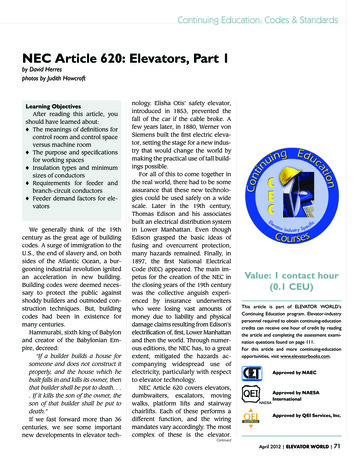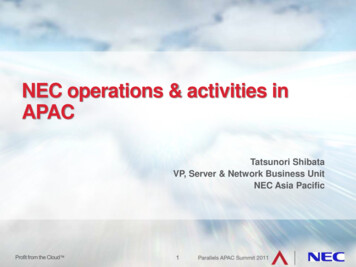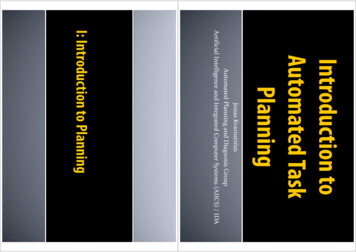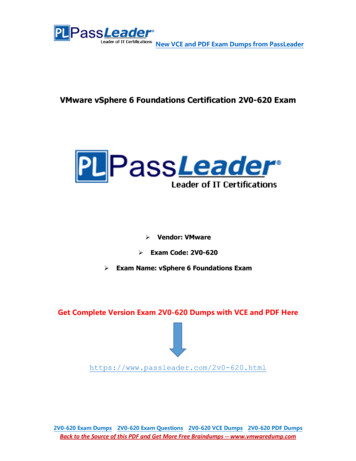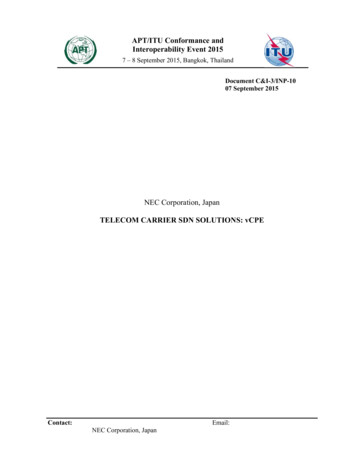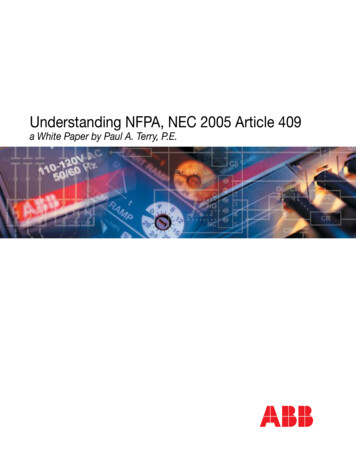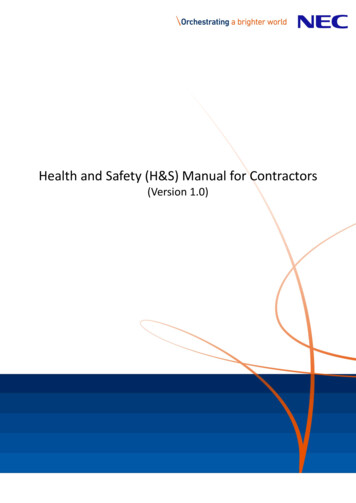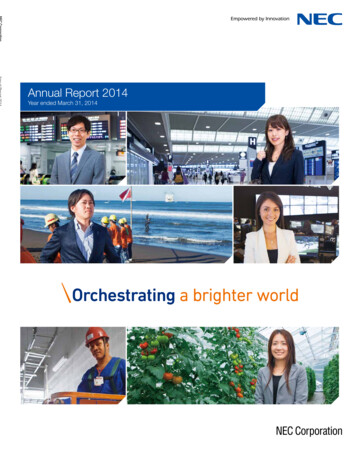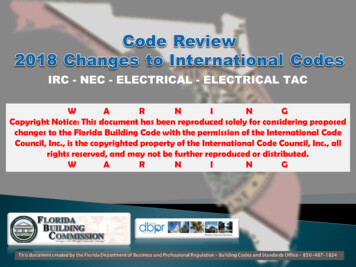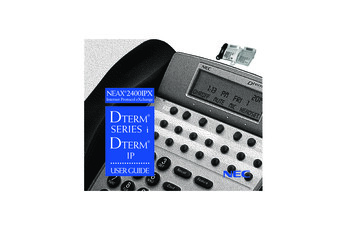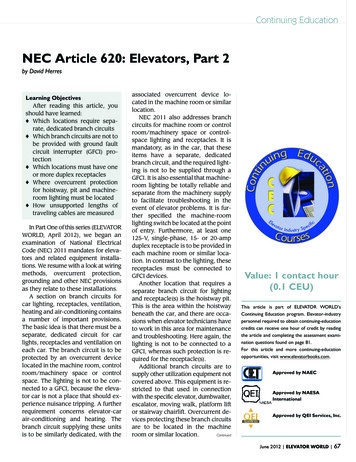
Transcription
Continuing EducationNEC Article 620: Elevators, Part 2by David HerresLearning ObjectivesAfter reading this article, youshould have learned: Which locations require separate, dedicated branch circuits Which branch circuits are not tobe provided with ground faultcircuit interrupter (GFCI) protection Which locations must have oneor more duplex receptacles Where overcurrent protectionfor hoistway, pit and machineroom lighting must be located How unsupported lengths oftraveling cables are measuredIn Part One of this series (ELEVATORWORLD, April 2012), we began anexamination of National ElectricalCode (NEC) 2011 mandates for elevators and related equipment installations. We resume with a look at wiringmethods, overcurrent protection,grounding and other NEC provisionsas they relate to these installations.A section on branch circuits forcar lighting, receptacles, ventilation,heating and air-conditioning containsa number of important provisions.The basic idea is that there must be aseparate, dedicated circuit for carlights, receptacles and ventilation oneach car. The branch circuit is to beprotected by an overcurrent devicelocated in the machine room, controlroom/machinery space or controlspace. The lighting is not to be connected to a GFCI, because the elevator car is not a place that should experience nuisance tripping. A furtherrequirement concerns elevator-carair-conditioning and heating. Thebranch circuit supplying these unitsis to be similarly dedicated, with theassociated overcurrent device located in the machine room or similarlocation.NEC 2011 also addresses branchcircuits for machine room or controlroom/machinery space or controlspace lighting and receptacles. It ismandatory, as in the car, that theseitems have a separate, dedicatedbranch circuit, and the required lighting is not to be supplied through aGFCI. It is also essential that machineroom lighting be totally reliable andseparate from the machinery supplyto facilitate troubleshooting in theevent of elevator problems. It is further specified the machine-roomlighting switch be located at the pointof entry. Furthermore, at least one125-V, single-phase, 15- or 20-ampduplex receptacle is to be provided ineach machine room or similar location. In contrast to the lighting, thesereceptacles must be connected toGFCI devices.Another location that requires aseparate branch circuit for lightingand receptacle(s) is the hoistway pit.This is the area within the hoistwaybeneath the car, and there are occasions when elevator technicians haveto work in this area for maintenanceand troubleshooting. Here again, thelighting is not to be connected to aGFCI, whereas such protection is required for the receptacle(s).Additional branch circuits are tosupply other utilization equipment notcovered above. This equipment is restricted to that used in connectionwith the specific elevator, dumbwaiter,escalator, moving walk, platform liftor stairway chairlift. Overcurrent devices protecting these branch circuitsare to be located in the machineroom or similar location.ContinuedValue: 1 contact hour(0.1 CEU)This article is part of ELEVATOR WORLD’sContinuing Education program. Elevator-industrypersonnel required to obtain continuing-educationcredits can receive one hour of credit by readingthe article and completing the assessment examination questions found on page 81.For this article and more continuing-educationopportunities, visit www.elevatorbooks.com.NATIONAL ASSOCIATIONOF ELEVATOR CONTRACTORS Approved by NAECCERTIFIEDELEVATOR TECHNICIANEDUCATION PROGRAMApproved by NAESAInternationalApproved by QEI Services, Inc.June 2012 ELEVATOR WORLD 67
Continuing Education ContinuedNEC Article 620 Part IV, Installation of Conductors,contains key mandates for elevator wiring. It begins byconsidering metal and nonmetallic wireways. These arecovered for generic, non-elevator specific use in earlierarticles, 376 and 378, in Chapter 3, Wiring Methods andMaterials. Beginning with Article 320, Armored Cable(Type AC) and concluding with Article 398, Open Wiringon Insulators, each code-sanctioned cable and raceway istreated, ranging from the familiar Type NM (trade name“Romex”) to the exotic Integrated Gas Spacer Cable (TypeIGS). As we have seen, a limited number of these are approved for elevator locations – car, hoistway, pit and machine room.Requirements in Article 620 modify the articles in Chapter 3. For example, it is stated that the cross-sectional areaof the individual conductors in a wireway are not to exceed 50% of the interior cross-sectional area of the wireway. (Cross-sectional areas of conductors are given inChapter 9, Tables 5 through 8. Cross-sectional areas ofconduits are given in Chapter 9, Table 4. Cross-sectionalareas of wireways are found by multiplying the two inte-Elevator drive motor: note the flexible metallic conduit as permitted to allow formotor vibration.68 WWW.ELEVATORWORLD.COM June 2012rior dimensions.) The basic rule for conductor fill of ametal wireway, as given in Article 376, is that the sum ofthe cross-sectional areas of all contained conductors at across section of a wireway is not to exceed 20% of theinterior cross-sectional area of the wireway. The samefigure applies to nonmetallic wireways. So, we see thatfor elevator work, greater fill is allowed. The sum of thecross-sectional area of the individual conductors in raceways is not to exceed 40% of the interior cross-sectionalarea of the raceway, except as permitted for wireways.Supports for cables or raceways in a hoistway or in anescalator or moving-walk wellway or platform lift andstairway chairlift runway must be securely fastened to theguide rail, escalator or moving-walk truss, or to the hoistway, wellway or runway construction. A raceway thatcomes loose on the inside of a hoistway could catch on amoving car, causing immense damage and hazard to users.The next section, 620.36, concerns different systems inone raceway or traveling cable. It is conditionally provided that fiber-optic cables and conductors for operatingdevices, operation and motion control, power, signaling,fire alarm, lighting, heating and air-conditioning circuitsof 600 V or less are permitted to be run in the same traveling cable or raceway system. The condition is that all conductors must be insulated for the maximum voltage applied to any conductor within the cables or racewaysystem, and all live parts of the equipment must be insulated from ground for this maximum voltage. The traveling cable or raceway is also permitted to include shieldedconductors and/or one or more coaxial cables. Thesemust also be insulated for the maximum voltage appliedto any conductor within the cable or raceway system.These conductors may be covered with suitable shieldingfor telephone, audio, video or higher-frequency communications circuits.Section 620.37 re-emphasizes that only wiring used inconnection with the elevator is permitted within thehoistway, machine room, control room/machinery spaceor control space. This may include wiring for signals,communication with the car, lighting, heating, air-conditioning and ventilation of the car or hoistway for fire-detecting systems and pit sump pumps.Bonding of elevator rails to a lightning-protection system grounding conductor is permitted, but the conductoritself is not to be located in the hoistway. The code notesthat elevator rails or other hoistway equipment are not tobe used as the grounding conductor for lightning-protection systems. The elevator rails, like the ground system ofthe entire building electrical structure, are to be bonded tothe lightning-system ground electrode so these all remainat the same potential even during a lightning event, ensuring side flash does not occur.Continued
Continuing Education ContinuedMain feeders that supply elevator power must be keptoutside the hoistway unless one of the following applies: Feeders for elevators are permitted within an existinghoistway (provided they are not spliced within thehoistway) by special permission of the AHJ. Feeders may be installed within the hoistway wherethe elevator has a driving-machine motor in the hoistway or on the car or counterweight.NEC Article 620 Part V, Traveling Cables, is driven bytwo major issues. First, the traveling cable must be composed of very fine-stranded conductors so it can flex witha minimum of internal stresses, ensuring long service lifeand reliability. Second, it must be configured so as toeliminate any chance of tangling or chafing against theinner surface of the hoistway or items mounted on it. Additionally, ampacities of the individual conductors andflame-retardant properties of the overall cable are important factors.It is stated that traveling cables are to be suspended atthe car and hoistway ends, or counterweight end whereapplicable, so as to reduce the strain on the individualcopper conductors to a minimum. Traveling cables are tobe supported by one of these means: Their steel supporting member(s) Looping the cables around supports for unsupportedlengths less than 100 ft. Suspending the cables from the supports by a meansthat automatically tightens around the cable when tension is increased for unsupported lengths up to 200 ft.An NEC Informational Note defines unsupportedlengths. When the elevator car is at the top landing, it isthe length of cable as measured from the point of suspension on the car to the bottom of the loop. With the elevator car at the bottom landing, it is the length of cable asmeasured from the point of suspension in the hoistway tothe bottom of the loop. Thus, the traveling cable must besupported by a steel supporting member.Traveling cables are to be approved for hazardous locations and must comply with the appropriate sectionsfor each hazardous-location class that covers use of flexible cords. (To design and install an elevator for a Class I,Division 1 location would be quite an undertaking.)Section 620.43, Location of and Protection for Cables,provides that traveling cable supports are to be located soas to reduce the possibility of damage due to the cablescoming in contact with the hoistway construction orequipment in the hoistway to a minimum. Where necessary, it is mandated that suitable guards be provided toprotect the cables against damage. Because they need tomove and flex, traveling cables are not required to be in araceway. They are permitted to be run without racewaywhen used inside the hoistway, on the elevator car, hoist-70 WWW.ELEVATORWORLD.COM June 2012way wall, counterweight, or controllers and machinerylocated inside the hoistway, provided they are in theiroriginal sheaths. The traveling cable, moreover, may berun without raceway from inside the hoistway to elevator-controller enclosures and to the elevator car and machine room and similar locations outside the hoistway fora distance not exceeding 6 ft. The conductors must be intheir original sheaths or grouped together and taped orcorded.NEC Article 620 Part VI, Disconnecting Means andControl, is rather exacting. It is of great importance thatpower to the various elevator functions can be quicklyand reliably removed from the loads in case of emergencyor for maintenance and troubleshooting. Of particular importance is the location of the disconnecting means so itcan be found by an individual who may not be familiarwith the installation. A single means for disconnecting allungrounded main power-supply conductors is requiredand must be designed so no pole can be operated independently. Where multiple driving machines are connectedto a single elevator, there is to be one disconnectingmeans to disconnect the motor(s) and control-valveoperating magnets.It is important, where mandated, that there be no morethan a single disconnecting means, so if emergencyaction is required, first responders will not be able topower down the equipment from one location. It is furtherstated that the disconnecting means are not to disconnectthe branch circuits required in sections 620.22, 620.23and 620.24. These are the individual branch circuits required for car lighting, receptacles, auxiliary lighting andventilation on each elevator car; individual branch circuits for machine-room and similar location lighting andreceptacle; and branch circuits for hoistway pit lightingand receptacle(s).The disconnecting means is to be an externally enclosed,operable, fused motor circuit switch or circuit breaker capable of being locked in the open position. The lockingcapability is important so during maintenance, the equipment will not be inadvertently energized. The disconnecting means is also to be a listed device. It is further stressedthat no provision is to be made to open or close the disconnecting means from any other part of the premises.Notwithstanding, if sprinklers are installed in hoistways,machine rooms or the like, the disconnecting means ispermitted to automatically open the power supply to theaffected elevator(s) prior to the application of water. Noprovision is to be made to automatically restore power.NEC Article 620 contains numerous other disconnectprovisions, which must be carefully scrutinized prior todesign work so the installation is compliant. Besides thepower-supply disconnect discussed, it is provided thatContinued
Continuing Education ContinuedElevator power disconnect (with utility feed marking) located in the machine roomor other permitted locationelevators have a single means for disconnecting all ungrounded car lights, receptacles and ventilation powersupply conductors for that elevator car. The disconnectingmeans is to be in the machine room or similar location,with provision for being locked in the open position. Similar provisions are attached to elevator-car heating andair-conditioning disconnecting means, and to other utilization equipment.Part VII, Overcurrent Protection, divides this topic intofour categories for elevators and similar equipment, depending upon the nature of the specific equipment: For operating devices and control and signaling circuits, protection against overcurrent is in accordancewith the requirements of Sections 725.43 and 725.45.These are part of Article 725, Class 1, Class 2 and Class3 Remote-Control, Signaling, and Power-Limited Circuits. The article stands apart from the rest of the codein the sense it exempts these categories of circuits fromthe general requirements for wiring in most occupancies, found in Chapter 3. Specifically, Section 725.43provides that overcurrent protection for conductors 14 AWGand larger is to be provided in accordance with theconductor ampacity without applying ampacity adjustment and correction factors. Section 725.45 concernsthe location of overcurrent devices and provides forfeeder and branch-circuit taps, transformer primary sideovercurrent device location and overcurrent device location at the input side of electronic power sources. Overload protection for motors is to conform with Article430, Part III, the general code area that covers motorand branch-circuit overload protection for all motors.Additionally, duty on elevator and dumbwaiter motors72 WWW.ELEVATORWORLD.COM June 2012is rated as intermittent, whereas duty on escalator andmoving-walk motors is considered continuous. Forplatform lifts and stairway chairlifts, the duty is intermittent. Motor feeder short circuit and ground-fault protectionmust be as required in Article 430, Part V for all motors. Similarly, motor branch-circuit short circuit andground-fault protection must be as required in Article430, Part IV, for all motors.Section 620.62, Selective Coordination, is central tomulti-elevator installations and must be closely observed.It provides that where more than one driving-machinedisconnecting means is supplied by a single feeder, theovercurrent protective devices in each disconnectingmeans are to be selectively coordinated with any othersupply side overcurrent protective devices. Proper selective coordination in a multi-elevator installation on thesame feeder ensures if one elevator develops a fault, theother units will not be shut down.Part VIII, Machine Rooms, Control Rooms, MachinerySpaces, and Control Spaces, states elevator and similarinstallation driving machines, motor-generator sets,motor controllers and disconnecting means are to be installed in a room or space set aside for that purpose. Thisroom is to be secured against unauthorized access (keptlocked). In case of emergency, electricians, maintenancepersonnel and any elevator technicians called in to thepremises should have ready access to the key.Motor controllers are permitted outside the spacesspecified above. They must be in enclosures with doors orremovable panels that can be locked in the closed position. The disconnecting means is to be located adjacentto or an integral part of the motor controller. If the disconnecting means is an integral part of the motor controller,it is to be operable without requiring opening of the enclosure. Elevators with driving machines located on thecar or counterweight, or in the hoistway are permittedoutside the specified spaces.Part IX, Grounding, states that metal raceways, TypeMC cable, Type MI cable or Type AC cable attached to elevator cars are to be bonded to metal parts of the carbonded to the equipment grounding conductor. (All intentionally grounded elements must be held at equal potential.) Both electric and nonelectric elevators are tocomply with Article 250, the code article that coversgrounding and bonding in general.Section 620.85, GFCI Protection for Personnel, providesthat 125-V, single-phase, 15- and 20-amp receptacles installed in pits, hoistways, machinery spaces, machinerooms, escalators and moving walks, and on elevator cartops are to be GFCIs. A single dedicated receptacle sup-
plying a permanently installed sump pump does not haveto be a GFCI type.Part X, Emergency and Standby Power Systems, is simple and straightforward. It states an elevator is permittedto be run by an emergency or standby power system. Forelevators that regenerate power back into a power sourceunable to absorb the regenerative power under overhauling elevator load conditions, a means to absorb this poweris to be provided. Other building loads, such as power andlighting, may function as the energy absorbing means,provided these loads are automatically connected to theemergency or standby power system operating the elevators and large enough to absorb the regenerative power.The disconnecting means must disconnect the elevatorfrom the emergency, standby and normal power systems.These are the principle NEC 2011 Article 620 mandates.Adhering to the requirements will ensure a hazard-freeelectrical installation. Other codes and standards interactwith the NEC, and it is necessary to see how they all worktogether in order to create safe and compliant elevatordesigns/installations.David Herres is the author of the recently published book 2011 National Electrical Code Chapter ByChapter. He holds a New Hampshire Electrician’sLicense and has worked as an electrician, journalist, plumber, carpenter and constructor. Herres haswritten for such publications as Electrical Constructionand Maintenance, Cabling Business Magazine, ElectricalContracting Products, Electrical Business and EngineeringNews Record since 2006. He holds a BA in EnglishLiterature and Composition from Hobart Collegeof Geneva, New York, but has focused exclusively on electrical work in NewHampshire since 2000.Learning-Reinforcement QuestionsUse the below learning-reinforcement questions tostudy for the Continuing Education Assessment Examavailable online at www.elevatorbooks.com or onpage 81 of this issue. Which equipment requires a separate branch circuitin the elevator car? Is lighting required to be GFCI protected in the machineroom? Where is the lighting switch to be located in the machine room? What is the maximum raceway conductor fill in anelevator hoistway? How many disconnecting means are required for anelevator power supply?June 2012 ELEVATOR WORLD 73
Continuing EducationELEVATOR WORLD Continuing EducationAssessment Examination QuestionsInstructions: Read the article “NEC Article 620: Elevators, Part 2” (page 67) and study thelearning-reinforcement questions at the end of the article. To receive one hour (0.1 CEU) of continuing-education credit, answer theassessment examination questions found below online at www.elevatorbooks.comor fill out the ELEVATOR WORLD Continuing Education Reporting Form found overleaf and submit by mail with payment. Approved for Continuing Education by NAEC for CET and NAESA Internationaland QEI Services, Inc. for QEI.1. Which location(s) require dedicated lighting branchcircuits?a. Car.b. Machine room.c. Hoistway pit.d. All of the above.6. Only wiring associated with the elevator is permittedwithin the:a. Hoistway.b. Machine room.c. Control room/machinery space.d. All of the above.2. Which location does not require a 125-V, single-phase,15- or 20-amp duplex receptacle?a. Car.b. Machine room.c. Hoistway pit.d. None of the above.7. Bonding of elevator rails to lightning down conductors is:a. Prohibited.b. Required.c. Optional.d. Asking for trouble.3. Traveling cables are to be suspended by:a. Their steel supporting members.b. Looping the cables around supports for unsupportedlengths less than 100 ft.c. Suspending from the supports by a means that automatically tightens around the cable where tensionis increased for unsupported lengths up to 200 ft.d. Any of the above.4. Traveling cables may be installed without raceway:a. Inside the hoistway.b. Outside the hoistway.c. Neither.d. Both, under certain conditions.5. If sprinklers are installed in the hoistway:a. The disconnecting means is to be omitted.b. The disconnecting means may be automatic.c. Both of the above.d. Neither of the above.8. Disconnecting means for car lighting:a. Is not required.b. May be located at the building entrance panel.c. Is usually located in the car.d. Is required to be in the machine room.9. Motor overload protection:a. Is covered in Article 430.b. Is required for over 25 hp only.c. Takes the place of branch-circuit, short-circuit andground-fault protection.d. Is always built into the motor.10. For elevators that regenerate power back into thepower source:a. A separate means is sometimes required to absorbexcess power.b. The power has to be separately metered by the utility.c. Other building loads, such as power and lighting,are prohibited from absorbing the excess.d. All of the above.ContinuedJune 2012 ELEVATOR WORLD 81
Continuing EducationELEVATOR WORLDContinuing EducationReporting FormCircle correct answerArticle title: “NEC Article 620:Elevators, Part 2” (EW, June 2012,page 67).Continuing-education credit:This article will earn you onecontact hour (0.1 CEU) of elevator-industry continuingeducation credit.Directions: Select one answerfor each question in the exam.Completely circle the appropriate letter. A minimum scoreof 80% is required to earn credit. You can also take this testonline at website: www.elevatorbooks.com.Last name:First name: Middle initial:CET , CAT or QEI number:1. abcd6.abcd2. abcd7.abcd3. abcd8.abcd4. abcd9.abcd5. abcd10. abcdSignature:Payment options:Check one: 30.00 – Non-subscriber course fee 25.50 – ELEVATOR WORLDsubscriber course feeSubscriber #:(6 digit number on your print label or inyour digital confirmation.) Payment enclosed(check payable to Elevator World, Inc.)State License number:Companyname:Address:City:State: ZIP code:Charge to my: VISA MasterCard American ExpressCard number:Telephone: Fax:E-mail:This article, “NEC Article 620: Elevators, Part 2,” is ratedfor one contact hour of continuing-education credit. Certification regulations require that we verify actual studytime with all program participants. Please answer thebelow question.How many hours did you spend reading the article andstudying the learning-reinforcement questions?hours minutesExpiration date:Signature:To receive your certificate of completion using the mailin option, send the completed form with questions answered and payment information included to: ElevatorWorld, Inc., P.O. Box 6507, Mobile, AL 36660.To receive your certificate of completion online, visitwebsite: www.elevatorbooks.com and follow the instructions provided for online testing.You now have the opportunity to earn Continuing Education contacthours in ELEVATOR WORLD magazine. Articles pertain to variousindustry topics that appear in the magazine bi-monthly, and for everyexam you successfully complete, you’ll earn 1–3 contact hours.As a subscriber, you not only have full access to these ContinuingEducation articles, but you also receive 15% off of the retail price.Your Subscription toELEVåTOR WÅRLDhas just become more valuable.Your subscription & all Online Continuing Education Courses can be purchased atelevatcrbooks.comELEVATOR WORLD’S ONLINE BOOKSTORE82 WWW.ELEVATORWORLD.COM June 2012
connection with the elevator is permitted within the hoistway, machine room, control room/machinery space or control space. This may include wiring for signals, communication with the car, lighting, heating, air-condi-tioning and ventilation of the car or hoistway for fire-de-tecting systems and pit sump pumps.
